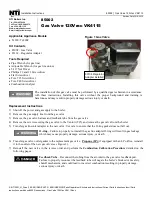
19
Part Number 550-142-320/0720
GWA
Series 3
Gas-Fired Water Boilers –
Boiler Manual
LEGEND:
3
System or zone circulator
7
System temperature valves (see instructions to the left for
adjusting valves)
8
Blend temperature gauge
9
Relief valve
10
Automatic air vent (with diaphragm-type expansion tank),
or connect to tank fitting (closed-type expansion tank).
DO
NOT
use an automatic air vent when using closed-type ex-
pansion tank. It would allow air to leave the system, causing
waterlogging of the expansion tank.
11
Fill valve
12
Diaphragm-type or bladder-type expansion tank, if used
(For closed-type expansion tank, pipe from top of air sepa-
rator to tank fitting as in Figure 6, page 11.)
Figure 16
System-bypass piping — Zoning with zone
valve or circulators, return water 130°F or higher
— (Alternative to boiler-bypass piping Figures
14 and 15, page 18).
Failure to
prevent low return water temperature
to the boiler could cause corrosion of the boiler sections or
burners, resulting in severe personal injury, death or substantial property damage.
Radiant heating system piping should include a means of
regulating the boiler return water temperature
and the
system supply temperature
(such as provided by an
injection pumping control
).
Boiler return water temperature will be adequately controlled using the methods shown in this manual pro-
vided the
system supply temperature
is
relatively constant.
DO NOT
apply the methods of this manual if the system is equipped with an
outdoor reset control.
Instead,
provide controls and piping
which can
regulate the boiler return water temperature
at
no less than 130°F
regardless of system supply temperature. Contact your Williamson-Thermoflo representative for suggested
piping and control methods.
Failure to
prevent cold return water temperature
to the boiler could cause corrosion damage to the sections
or burners, resulting in possible severe personal injury, death or substantial property damage.
SYSTEM-bypass piping method
This piping method (Figure 16) is called a
system-bypass
be-
cause part of the circulator flow bypasses the system (through
valve
7a
). This bypassed hot water from the boiler outlet mixes
with cooler system return water temperature in order to pro-
vide minimum 130°F return water to the boiler. Valve
7b
will
most often be full open, but may need to be slightly closed
on some low pressure drop systems in order to cause enough
flow through valve
7a
.
Figure 16
is an alternative piping method that provides return
water temperature control for boilers installed on
converted
gravity systems
(large water content or steam systems).
DO NOT
apply the piping of Figure 16 on
radiant heating
systems
. It provides no method of regulating the water tem-
perature provided to the system and could result in excessive
water temperature in the radiant tubing.
System-bypass piping as shown in Figure 16 can be used with
either zone valve or circulator zoning. When used with circulator
zoning however, the boiler circulator (item
3), must be piped
as shown. It cannot be used as one of the zoning circulators.
DO NOT
apply system-bypass piping if the reduced flow in the
system could cause poor heat distribution. That is, system-
bypass piping reduces the flow in the system and increases
the water temperature supplied to the system. This can cause
increased heat from radiators at the beginning of the system
and reduced heat from radiators near the end of the system.
Valve adjustment
1. Start
with valve
7a
fully closed and
7b
fully open.
2. Gradually open valve
7a
while closing valve
7b
until the
temperature at gauge
8
reads at least 130°F at all times.
3. Valve
7a
regulates the amount of boiler supply water mixed
with return water. Valve
7b
causes a pressure drop in the
system needed to balance flow through valve
7a
and the
system.
4. The valve adjustment should be done with the system at the
coldest expected temperature (60°F for converted gravity
systems or high mass radiant systems).
5 Water piping — multiple zones
continued
Water piping — low temperature systems
continued
















































